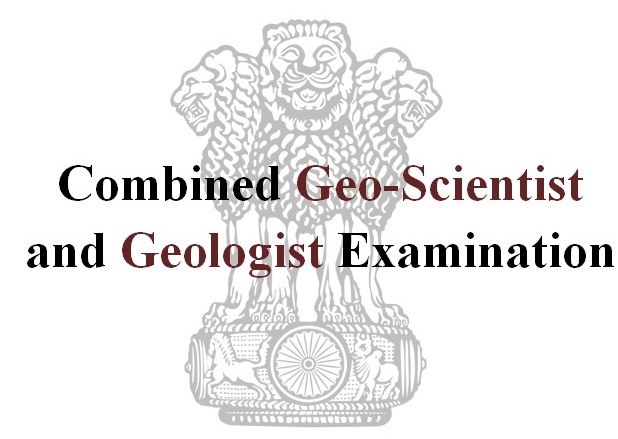UPSC Revised Syllabus 2020 Combined Geo-Scientist Exam : Union Public Service Commission
Organisation : Union Public Service Commission
Exam Name : Combined Geo-Scientist Examination 2020
Announcement : Revised Syllabus
Website : https://www.upsc.gov.in/examinations/revised-syllabus-scheme
UPSC Revised Syllabus
Union Public Service Commission, Combined Geo-Scientist Examination 2020 Revised Syllabus
Related / Similar Syllabus :

Syllabus
Stage-I (Objective Type):
Paper-I : General Studies (Common for all streams)
** Current events of national and international importance.
** History of India and Indian National Movement.
** Indian and World Geography -Physical, Social, Economic Geography of India and the World.
** Indian Polity and Governance -Constitution, Political System, Panchayati Raj, Public Policy, Rights Issues, etc.
** Economic and Social Development – Sustainable Development, Poverty, Inclusion, Demographics, Social Sector initiatives, etc.
** General issues on Environmental Ecology, Bio-diversity and Climate Change – that do not require subject specialisation
** General Science

Stage-I (Objective Type):
Paper-II : Geology/Hydrogeology
1. Physical Geology:
Principle of uniformitarianism; origin, differentiation and internal structure of the Earth; origin of atmosphere; earthquakes and volcanoes; continental drift, sea-floor spreading, isostasy, orogeny and plate tectonics; geological action of rivers, wind, glaciers, waves; erosional and depositional landforms; weathering processes and products.
2. Structural Geology:
Stress, strain and rheological properties of rocks; planar and linear structures; classification of folds and faults; Mohr’s circle and criteria for failure of rocks; ductile and brittle shear in rocks; study of toposheets, V-rules and outcrop patterns; stereographic projections of structural elements.
3. Mineralogy:
Elements of symmetry, notations and indices; Bravais lattices; chemical classification of minerals; isomorphism, polymorphism, solid solution and exsolution; silicate structures; physical and optical properties of common rock forming minerals- olivine, garnet, pyroxene, amphibole, mica, feldspar and quartz.
4. Igneous Petrology:
Magma types and their evolution; IUGS classification of igneous rocks; forms, structures and textures of igneous rocks; applications of binary and ternary phase diagrams in petrogenesis; magmatic differentiation and assimilation; petrogenesis of granites, basalts, komatiiites and alkaline rocks (carbonatite, kimberlite, lamprophyre and nepheline syenite).
5. Metamorphic Petrology:
Limits, types and controls of metamorphism; metamorphic structuresslate, schist and gneiss; metamorphic textures- pre, syn and post tectonic porphyroblasts; concept of metamorphic zone, isograd and facies; geothermal gradients, facies series and plate tectonics.
6. Sedimentology:
Origin of sediments; sedimentary textures, grain-size scale; primary sedimentary structures; classification of sandstone and carbonate rocks; siliciclastic depositional environments and sedimentary facies; diagenesis of carbonate sediments.
7. Paleontology:
Fossils and processes of fossilization; concept of species and binomial nomenclature; morphology and classification of invertebrates (Trilobites, Brachiopods, Lamellibranchs, Gastropods and Cephalopods); evolution in Equidae and Hominidae; microfossils-Foraminifera, Ostracoda; Gondwana flora.
8. Stratigraphy:
Law of superposition; stratigraphic nomenclature- lithostratigraphy, biostratigraphy and chronostratigraphy; Archaean cratonic nucleii of Peninsular India (Dharwar, Singhbhum, and Aravalli cratons); Proterozoic mobile belts (Central Indian Tectonic Zone, Aravalli-Delhi and Eastern Ghats); Purana sedimentary basins (Cuddapah and Vindhyan); Phanerozoic stratigraphy of India- Spiti, Kashmir, Damodar valley, Kutch, Trichinopoly, Siwaliks and Indo-Gangetic alluvium.
9. Economic Geology:
Properties of mineral deposits- form, mineral assemblage, texture, rockore association and relationship; magmatic, sedimentary, metamorphic, hydrothermal, supergene and weathering-related processes of ore formation; processes of formation of coal and petroleum; distribution and geological characteristics of major mineral and hydrocarbon deposits of India.
Download Syllabus
Download Here : http://www.syllabus.gen.in/uploads/pdf2020/1788-syl.pdf